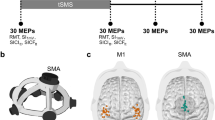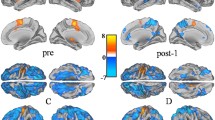Abstract
We evaluated the effects of high-frequency repetitive transcranial magnetic stimulation (rTMS) on motor performance and motor learning of a rapid index finger movement. Two groups of healthy right-handed subjects underwent either “real” rTMS (1800 stimuli over the first dorsal interosseous (FDI) muscle hot spot given at 5 Hz and intensity of 90% of resting motor threshold—RMT) or “sham” stimulation. Both groups performed 60 rapid abductions of the right index finger before and after rTMS. The kinematic variables measured were amplitude, duration, peak velocity and peak acceleration. We also evaluated RMT and motor-evoked potential (MEP) amplitude before, 5 and 30 min after rTMS. In both groups practice significantly increased peak velocity, peak acceleration and amplitude and decreased movement duration independently from the type of intervention (“real” and “sham”). “Real” rTMS significantly increased cortical excitability as measured by MEP amplitude whereas “sham” rTMS did not. In our study, 5 Hz rTMS failed to improve either the motor performance or the motor learning of a rapid index-finger abduction despite the increase in cortical excitability of the primary motor cortex. Since motor behaviour engages a distributed cortical and subcortical neuronal network, excitatory conditioning of the primary motor cortex is probably not sufficient to influence the behavioural output.





Similar content being viewed by others
References
Baraduc P, Lang N, Rothwell J, Wolpert DM (2004) Consolidation of dynamic motor learning is not disrupted by rTMS of primary motor cortex. Curr Biol 14:252–256
Bliss TV, Collingridge GL (1993) A synaptic model of memory: long-term potentiation in the hippocampus. Nature 361:31–39
Castro-Alamancos MA, Connors BW (1996) Short-term synaptic enhancement and long-term potentiation in neocortex. Proc Natl Acad Sci USA 93:1335–1339
Catalan MJ, Honda M, Weeks RA, Cohen LG, Hallett M (1998) The functional neuroanatomy of simple and complex sequential finger movements: a PET study. Brain 121:253–264
Classen J, Liepert J, Wise SP, Hallett M, Cohen LG (1998) Rapid plasticity of human cortical movement representation induced by practice. J Neurophysiol 79:1117–1123
Corcos DM, Jaric S, Agarwal GC, Gottlieb GL (1993) Principles for learning single-joint movements. I. Enhanced performance by practice. Exp Brian Res 94:499–513
Deiber MP, Honda M, Ibanez V, Sadato N, Hallett M (1999) Mesial motor areas in self-initiated versus externally triggered movements examined with fMRI: effect of movement type and rate. J Neurophysiol 81:3065–3077
Flament D, Shapiro MB, Kempf T, Corcos DM (1999) Time course and temporal order of changes in movement kinematics during learning of fast and accurate elbow flexions. Exp Brain Res 129:441–450
Gottlieb GL, Corcos DM, Jaric S, Agarwal GC (1988) Practice improves even the simplest movements. Exp Brain Res 73:436–440
Huang YZ, Edwards MJ, Rouins E, Bhatia KP, Rothwell JC (2005) Theta burst stimulation of the human motor cortex. Neuron 45:201–206
Jäncke L, Steinmetz H, Benilow S, Ziemann U (2004) Slowing fastest finger movements of the dominant hand with low-frequency rTMS of the hand area of the primary motor cortex. Exp Brain Res 155:196–203
Jenkins IH, Passingham RE, Brooks DJ (1997) The effect of movement frequency on cerebral activation: a positron emission tomography study. J Neurol Sci 151:195–205
Karni A, Meyer G, Jezzard P, Adams MM, Turner R, Ungerleider LG (1995) Functional MRI evidence for adult motor cortex plasticity during motor skill learning. Nature 377:155–158
Kim YH, Park JW, Ko MH, Jang SH, Lee PKW (2004) Facilitative effect of high frequency subthreshold repetitive transcranial magnetic stimulation on complex sequential motor learning in humans. Neurosci Lett 367:181–185
Kim YH, You SH, Ko MH, Park JW, Lee KH, Jang SH, Yoo WK, Hallett M (2006) Repetitive transcranial magnetic stimulation-induced corticomotor excitability and associated motor skill acquisition in chronic stroke. Stroke 37:1471–1476
Lefaucher JP, Drouot X, Von Raison F, Mefaucher I, Cesaro P, Nguyen JP (2004) Improvement of motor performance and modulation of cortical excitability by repetitive transcranial magnetic stimulation of the motor cortex in Parkinson’s disease. Clin Neurophysiol 115:2530–2541
Lomarev MP, Kanchana S, Bara-Jimenez W, Iyer M, Wassermann EM, Hallett M (2006) Placebo-controlled study of rTMS for the treatment of Parkinson’s disease. Mov Disord 21:325–331
Mima T, Sadato N, Yazawa S, Hanakawa T, Fukuyama H, Yonekura Y, Shibasaki H (1999) Brain structures related to active and passive finger movements in man. Brain 122:1989–1997
Modugno N, Nakamura J, MacKinnon CD, Filipovic SR, Bestmann S, Berardelli A, Rothwell JC (2001) Motor cortex excitability following short trains of repetitive magnetic stimuli. Exp Brain Res 140:453–459
Muellbacher W, Ziemann U, Boroojerdi B, Cohen L, Hallett M (2001) Role of the human motor cortex in rapid motor learning. Exp Brain Res 136:431–438
Muellbacher W, Ziemann U, Wissel J, Dang N, Kofler M, Facchini S, Boroojerdi B, Poewe W, Hallett M (2002) Early consolidation in human primary motor cortex. Nature 415:640–644
Pascual-Leone A, Valls-Solé J, Brasil-Neto JP, Cammarota A, Grafman J, Hallett M (1994) Akinesia in Parkinson’s disease. II. Effects of subthreshold repetitive transcranial motor cortex stimulation. Neurology 44:892–898
Pascual-Leone A, Nguyet D, Cohen LG, Brasil-Neto JP, Cammarota A, Hallett M (1995) Modulation of muscle responses evoked by transcranial magnetic stimulation during the acquisition of new fine motor skills. J Neurophysiol 74:1037–1045
Peinemann A, Reimer B, Loer C, Quartarone A, Munchau A, Conrad B, Siebner HR (2004) Long-lasting increase in corticospinal excitability after 1800 pulses of subthreshold 5 Hz repetitive TMS to the primary motor cortex. Clin Neurophysiol 115:1519–1526
Quartarone A, Bagnato S, Rizzo V, Morgante F, Sant’Angelo A, Battaglia F et al (2005) Distinct changes in cortical and spinal excitability following high-frequency repetitive TMS to the human motor cortex. Exp Brain Res 161:114–124
Rao SM, Bandettini PA, Binder JR, Bobholz JA, Hammeke TA, Stein EA, Hyde JS (1996) Relationship between finger movement rate and functional magnetic resonance signal change in human primary motor corex. J Cereb Blood Flow Metab 16:1250–1254
Sakai K, Ramnani N, Passingham RE (2002) Learning of sequences of finger movements and timing: frontal lobe and action-oriented representation. J Neurophysiol 88:2035–2046
Schlaug G, Sanes JN, Thangaraj V, Darby DG, Jancke L, Edelman RR, Warach S (1996) Cerebral activation covaries with movement rate. Neuroreport 7:879–883
Siebner HR, Rothwell J (2003) Transcranial magnetic stimulation: new insights into representational cortical plasticity. Exp Brain Res 148:1–16
Siebner HR, Mentschel C, Auer C, Conrad B (1999) Repetitive transcranial magnetic stimulation has a beneficial effect on bradykinesia in Parkinson’s disease. Neuroreport 10:589–594
Stefan K, Kunesch E, Cohen LG, Benecke R, Classen J (2000) Induction of plasticity in the human motor cortex by paired associative stimulation. Brain 123:572–584
Strens LHA, Fogelson N, Shanahan P, Rothwell J, Brown P (2003) The ipsilateral human motor cortex can functionally compensate for acute contralateral motor cortex dysfunction. Curr Biol 13:1201–1205
Touge T Gerschlager W, Brown P, Rothwell JC (2001) Are the after-effects of low-frequency rTMS on motor cortex excitability due to changes in the efficacy of cortical synapses? Clin Neurophysiol 112:2138–2145
Turner RS, Grafton ST, Votaw JR, Delong MR, Hoffman JM (1998) Motor subcircuits mediating the control of movement velocity: a PET study. J Neurophysiol 80:2162–2176
Wassermann EM (1998) Risk and safety of repetitive transcranial magnetic stimulation: report and suggested guidelines from the International Workshop on the Safety of Repetitive Transcranial Magnetic Stimulation, June 5–7, 1996. Electroencephalogr Clin Neurophysiol 108:1–16
Wu T, Hallett M (2005) A functional MRI study of automatic movements in patients with Parkinson’s disease. Brain 128:2250–2259
Author information
Authors and Affiliations
Corresponding author
Rights and permissions
About this article
Cite this article
Agostino, R., Iezzi, E., Dinapoli, L. et al. Effects of 5 Hz subthreshold magnetic stimulation of primary motor cortex on fast finger movements in normal subjects. Exp Brain Res 180, 105–111 (2007). https://doi.org/10.1007/s00221-006-0838-3
Received:
Revised:
Accepted:
Published:
Issue Date:
DOI: https://doi.org/10.1007/s00221-006-0838-3




